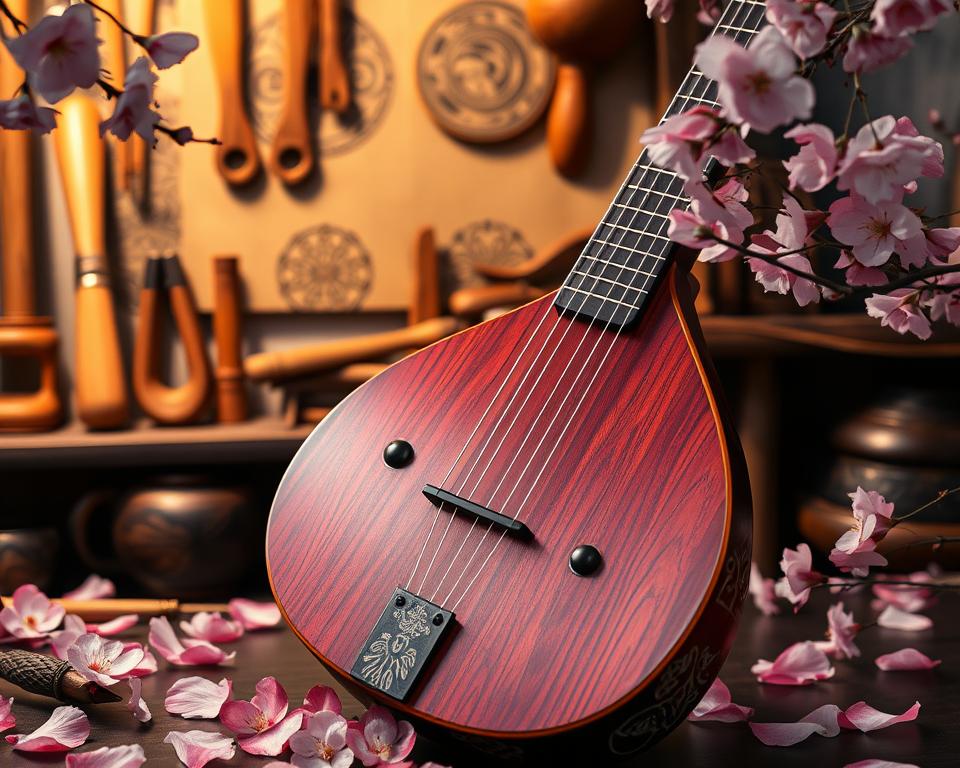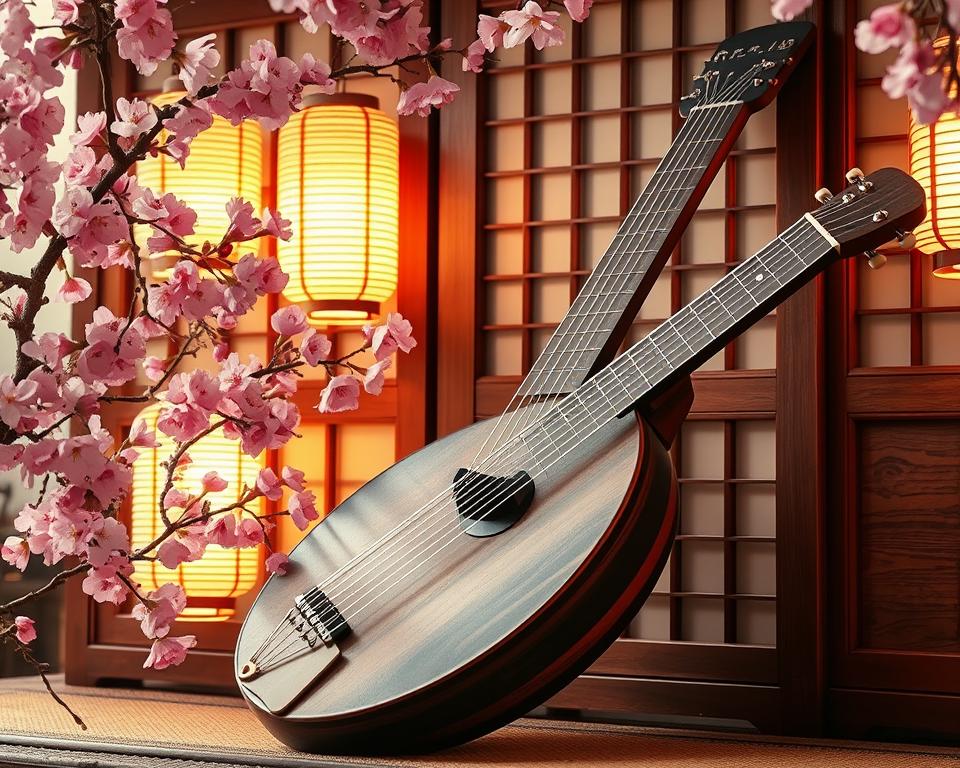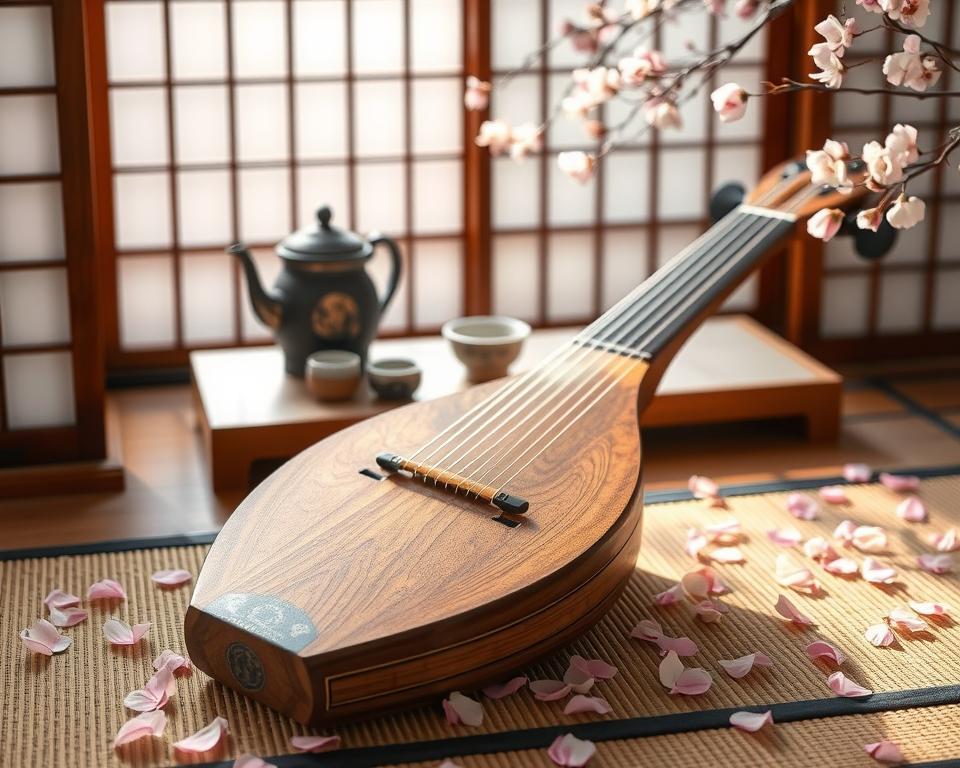The shamisen is a three-stringed lute-like instrument that has been a key part of Japan’s music for centuries. It started in the 16th century and has grown into many styles. Each style shows the rich cultural diversity of Japan.
From the lively Tsugaru shamisen to its ties with the biwa, koto, and sanxian, the shamisen’s impact is vast. It reaches far beyond Japanese music, touching many cultures.
Read interesting things at : info-kirara
Key Takeaways
- The shamisen is a traditional three-stringed lute-like instrument that has been a part of Japanese music and culture for centuries.
- Originating in the 16th century, the shamisen has evolved into various distinctive styles, each reflecting Japan’s diverse cultural heritage.
- The shamisen is closely connected to other traditional Japanese instruments, such as the biwa, koto, and sanxian.
- The shamisen has become a symbol of Japan’s rich musical legacy and continues to captivate audiences worldwide.
- The instrument’s unique construction and playing techniques are integral to its distinctive sound and cultural significance.
Exploring the Shamisen: A Captivating Japanese Instrument
The shamisen, a quintessential Japanese three-stringed instrument, has enchanted listeners for centuries. It’s often likened to a Japanese lute. The shamisen has a square body, long neck, and silk strings. It produces a captivating sound deeply rooted in Japan’s traditions.
The shamisen is loved in many musical genres. From the haunting melodies of Okinawan music to the dynamic rhythms of Tsugaru shamisen. Its versatility and expressive capabilities make it a key part of Japanese music.
Mastering the shamisen takes immense skill and dedication. The intricate playing techniques and nuanced tones require years of practice. The instrument’s sound, ranging from delicate to powerful, has captivated audiences worldwide. It showcases Japan’s musical heritage.
“The shamisen is not just an instrument – it is a window into the heart and soul of Japanese culture.”
| Characteristic | Description |
|---|---|
| Body Shape | Square-shaped, with a long, slender neck |
| Number of Strings | Three silk strings |
| Tuning | Typically tuned in a pentatonic scale |
| Playing Technique | Plucked with a large, rectangular plectrum called a bachi |
The shamisen is a true embodiment of Japan’s musical traditions. It captivates audiences with its unique sound and cultural significance. As we explore this extraordinary instrument, we discover a captivating story that speaks to Japan’s artistic legacy.
What is a Shamisen?
The shamisen is a three-stringed instrument that’s a big part of Japan’s traditional music. It has a square body and a long neck. This makes it sound rich and versatile.
Origins and History of the Shamisen
The shamisen came to Japan from China in the 16th century. Over time, it became a key part of Japanese culture. Different areas in Japan have their own ways of playing it.
The Unique Construction of the Shamisen
The shamisen is made from top-notch materials like hardwood, snakeskin, and silk. These materials give it a special sound. Its square body and long neck let players use many techniques to express music.
| Key Features of the Shamisen | Description |
|---|---|
| Body Shape | Square-shaped |
| Neck Length | Long and slender |
| Strings | Three silk or nylon strings |
| Materials | Hardwood, snakeskin, and silk |
The shamisen’s special design and many regional styles make it a fascinating instrument. It’s a big part of Japan’s music and culture.
Styles and Variations of Shamisen Playing
The shamisen, a traditional Japanese lute, has evolved over the centuries. It has given rise to various regional playing styles and adaptations. From the vibrant and percussive Tsugaru-style shamisen to the more lyrical Okinawan-style, each tradition showcases the versatility and adaptability of this iconic instrument.
The Tsugaru shamisen comes from the Tsugaru region of northern Japan. It is known for its energetic and rhythmic approach. This style features rapid plucking, percussive techniques, and a distinct, powerful sound. On the other hand, the Okinawan-style shamisen is famous for its soulful and melodic qualities. It often accompanies traditional Okinawan music and dance performances.
Beyond these regional styles, the shamisen has also been integrated into various forms of traditional Japanese music. It is used in kabuki theater, noh drama, and bunraku puppet performances. Each of these artistic traditions has influenced the shamisen’s style and repertoire. This shows the instrument’s remarkable versatility and cultural significance.
Exploring the dynamic Tsugaru-style or the lyrical Okinawan-style, the shamisen’s diverse playing techniques and regional variations offer a captivating glimpse into traditional Japanese music and culture.
The Shamisen in Traditional Japanese Music
The shamisen, a unique Japanese lute, is deeply loved in traditional Japanese music. It’s used in Kabuki theater and classical Gagaku, adding a special touch to Japan’s music. Its sound is a key part of Japan’s musical history.
Genres and Ensembles Featuring the Shamisen
The shamisen shines in many traditional Japanese music genres. In Kabuki, it brings depth and emotion to the performances. In Gagaku, it harmonizes with other instruments, creating beautiful sounds.
In folk music, like Minyo and Tsugaru-jamisen, the shamisen is a star. It shows off its skill and emotion, leading the music.
| Traditional Japanese Music Genres | Shamisen’s Role |
|---|---|
| Kabuki Theater | Accompaniment for dramatic narratives |
| Gagaku Court Music | Integral part of the ensemble |
| Minyo Folk Songs | Leading instrument in melodic performances |
| Tsugaru-jamisen | Showcases virtuosic techniques |
The shamisen’s role in traditional Japanese music is vital. It adds a unique sound to many genres and ensembles.
“The shamisen’s haunting melodies have the power to transport listeners to the heart of Japan’s cultural heritage.”
Shamisen: A Symbol of Japanese Culture
The shamisen, a traditional Japanese lute, is more than just a musical instrument. It has become a powerful symbol of Japanese culture. Its unique shape and sound are known all over the world. The shamisen connects Japan’s artistic and cultural traditions to its rich history.
The shamisen is a key part of traditional Japanese culture. Its three-stringed design and deep sound remind us of Japan’s cultural heritage. It brings to mind centuries-old Okinawan music and the detailed performances of kabuki theater.
The shamisen’s impact goes beyond music. Its distinctive look appears in many art forms, from woodblock prints to modern fashion. This widespread presence keeps the shamisen’s importance in Japanese culture alive.
“The shamisen is more than just an instrument; it is a living, breathing embodiment of Japan’s artistic soul.”
Even as Japan faces the challenges of modern times, the shamisen stands as a symbol of its enduring traditions. The skill of playing the shamisen and the care for its craft link Japan’s past to its present. This ensures the Japanese lute‘s legacy will continue to echo for many years.
The Art of Shamisen Making
Making a shamisen, Japan’s traditional lute, is a fascinating show of traditional craftsmanship. This detailed instrument is built with top-notch materials. Each material is key to its unique sound and look.
Traditional Craftsmanship and Materials
The shamisen starts with the best hardwood for its neck and body. Artisans then stretch a snakeskin over the body, giving it its tight surface. The final step is adding silk strings, tuned to create its beautiful sounds.
| Material | Purpose |
|---|---|
| Hardwood | Neck and resonating body |
| Snakeskin | Membrane stretched over body |
| Silk | Strings |
Creating a shamisen shows the talent and hard work of Japanese craftspeople. Every step, from picking materials to putting the instrument together, is vital. It keeps the shamisen’s cultural heritage alive.

“The shamisen is not just an instrument, but a work of art that embodies the essence of Japanese culture.”
Legendary Shamisen Players and Masters
The shamisen, a captivating Japanese lute, has been played by legendary musicians for centuries. These skilled players have not only shown incredible technical skill. They have also helped keep the shamisen’s rich traditions alive for future generations.
Takehiro Hirao is one of the most respected shamisen masters. He is known for his amazing dexterity and deep understanding of the shamisen’s music. Hirao’s performances are loved for their emotional depth and ability to take listeners into the heart of traditional Japanese music.
Kenichi Tanaka is another iconic shamisen player. His Tsugaru-style playing, known for fast plucking and rhythm, has won fans worldwide. It has also inspired many new shamisen fans.
“The shamisen is not just an instrument; it’s a vessel for the soul of Japanese culture. These masters have dedicated their lives to perfecting its art and ensuring its legacy endures.”
Other famous shamisen players include Yoshikazu Iwamoto and Koji Nakamura. Iwamoto is known for his beautiful interpretations of classic shamisen music. Nakamura has mixed traditional shamisen with modern music styles, pushing the instrument’s limits.
These legendary shamisen players have amazed audiences with their skill. They have also played a key role in keeping the shamisen’s cultural heritage alive. This ensures the shamisen remains relevant in today’s world of traditional Japanese music.
Learning to Play the Shamisen
Learning the shamisen, a traditional Japanese lute, needs dedication and patience. It also requires special techniques. With help from experienced teachers, beginners can learn to play the shamisen well.
Techniques and Challenges for Beginners
First, beginners must learn how to hold and play the shamisen. They need to master the tsuku (plucking) technique. This skill is key for expressing different rhythms and emotions.
They also need to work on strumming and vibrato. These skills add depth and feeling to the music.
One big challenge is understanding the shamisen‘s unique tuning and fretting. Its three strings are tuned in a special way. Learning to play them clearly and with good tone takes time.
“The shamisen is a delicate instrument that requires a gentle touch and a deep understanding of its traditional techniques. With patience and dedication, beginners can unlock the true beauty of this iconic Japanese lute.”
Beginners also need to improve their sense of rhythm and tempo. The shamisen is key in traditional Japanese music groups. Playing in sync with others and keeping a steady beat is hard to learn.
With the help of skilled teachers and regular practice, beginners can beat the shamisen learning hurdles. They’ll find joy and beauty in playing this Japanese lute.
The Shamisen’s Influence on Modern Japanese Music
The shamisen, a traditional Japanese lute, has a deep history in Japan’s music. It has also made a big impact on modern Japanese music. Artists have mixed the shamisen’s sound with many genres, like pop, rock, and fusion. This shows how the shamisen’s sound is loved and can fit into many styles.
The shamisen works well with today’s music. Renowned Japanese musicians use its sound to make new, exciting music. This mix of old and new keeps the shamisen’s place in music alive and growing.
The shamisen’s role in music has grown from traditional to modern. It’s used in everything from quiet melodies to upbeat pop songs. It shows how music can change and still keep its roots. The shamisen keeps Japan’s music traditions alive for new artists to explore.

“The shamisen’s capacity to blend seamlessly with diverse musical styles is a testament to its enduring cultural significance and artistic versatility.”
Shamisen in Popular Culture
The shamisen, a Japanese lute, has become more than just a traditional instrument. It’s a symbol of Japan’s rich culture, loved by many around the world. Its presence in popular media has made it an iconic part of Japan’s artistic legacy.
Appearances in Film, Literature, and Media
In films, the shamisen’s beautiful sounds and unique look add to the movie magic. It’s a key part of Japanese cinema and anime, reaching audiences globally. This has made it a beloved part of our cultural world.
In books, the shamisen’s sounds bring traditional Japanese culture to life. It’s also a common sight in TV shows and ads, showing Japan’s lasting cultural impact.
| Medium | Shamisen Appearances |
|---|---|
| Film |
|
| Anime |
|
| Literature |
|
The shamisen’s role in popular culture has made it a treasured symbol of Japan’s artistic and cultural heritage. Its lasting impact is clear to see.
Preserving the Legacy of the Shamisen
The shamisen, a revered traditional Japanese lute, has been a key part of Japan’s music for centuries. As time goes by, it’s clear how vital it is to keep its legacy alive. In Japan and around the world, many are working hard to protect this iconic instrument.
They do this through education, apprenticeships, and cultural events. These efforts aim to keep the unique sound and playing techniques of the shamisen alive. By doing so, they help keep the shamisen’s spirit alive for all to enjoy.
Special shamisen schools are a big part of this effort. Here, skilled masters teach the next generation of musicians. These schools are key in keeping the shamisen’s legacy alive and growing.
Cultural festivals and performances also play a big role. They showcase the shamisen’s beauty and diversity. These events entertain and teach people about the shamisen’s history and importance.
Thanks to these efforts, the preservation of the shamisen is a top priority. This ensures the shamisen’s impact on Japan’s music will continue to be felt. As the world connects more, the shamisen’s unique voice reaches more people, promising a bright future for its legacy.
Related Instruments: Biwa, Koto, and Sanxian
The shamisen is a special Japanese lute, but it’s not alone. The biwa, koto, and sanxian are similar instruments with their own histories and sounds. They all play important roles in Japan’s music.
The biwa is a four-stringed lute shaped like a pear. It’s often linked to the music of Japan’s imperial court. The koto is a 13-stringed zither known for its beautiful sounds and complex playing. The sanxian, a three-stringed Chinese lute, also plays a big part in Japan’s music.
| Instrument | Origin | Strings | Tuning | Musical Styles |
|---|---|---|---|---|
| Biwa | Japan | 4 | Pentatonic | Imperial court music, Buddhist chants |
| Koto | Japan | 13 | Pentatonic | Classical, contemporary, and folk music |
| Sanxian | China | 3 | Pentatonic | Traditional Chinese music, Japanese folk music |
These instruments, including the shamisen, are key to Japan’s rich music heritage. Each one adds its own special touch to Japan’s cultural story.
“The shamisen, biwa, koto, and sanxian are not just instruments, but living embodiments of Japan’s cultural identity, each with its own story to tell.”
Conclusion
The shamisen is a key part of Japan’s music history. It has a rich past, a unique sound, and deep cultural value. This Japanese lute has amazed people for centuries, from traditional shows to its impact on modern music.
As the shamisen changes and inspires new musicians, its lasting impact shows the strength of traditional arts. It helps us understand traditional Japanese music and cultural significance better.
The shamisen is very versatile, fitting into many music styles and groups. Its special sound comes from its design and playing methods. This sound is a big part of Japanese culture.
The hard work of shamisen makers and skilled players has kept this art alive. They make sure it’s loved and respected.
Exploring the shamisen shows us the beauty and importance of traditional Japanese arts. It draws in and inspires people everywhere. This shows the shamisen‘s lasting charm and its big role in Japan’s music.
As we end this journey, the shamisen remains a precious symbol of Japan’s cultural wealth. It waits for the next group of musicians and fans to keep its legacy alive.
